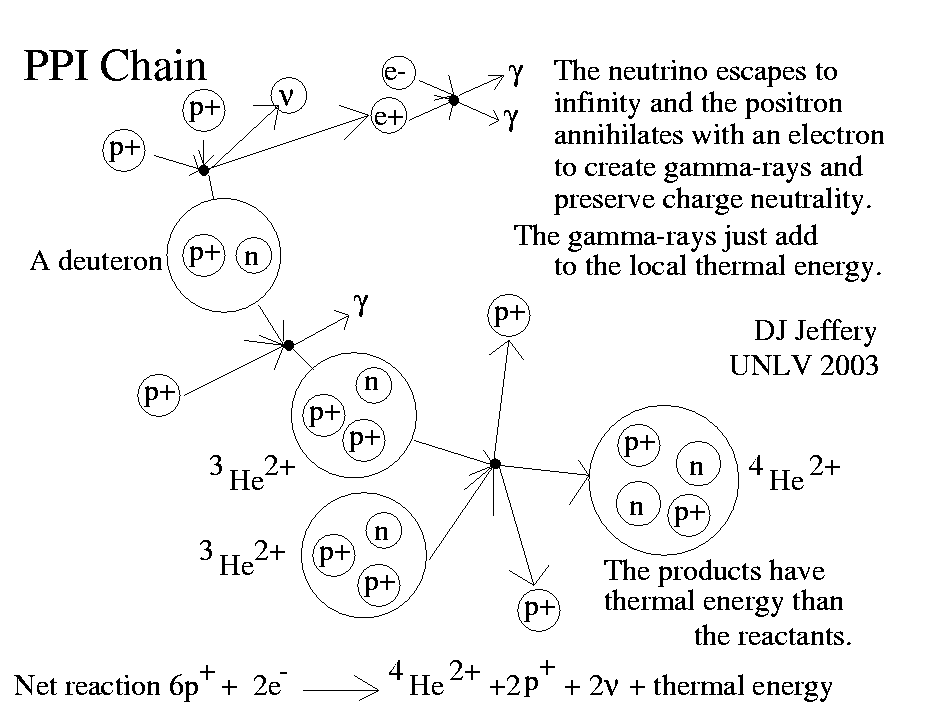
Caption: The proton-proton chain in the pp I branch.
Features:
- The dominant
hydrogen burning
(i.e., H-to-He-4 burning) process
in stars
less than ∼ 1.5 M_☉
(e.g., the Sun) is the
proton-proton chain reaction
(HI-343;
Cl-369)
which comes in three versions
the pp I branch,
the pp II branch,
and the pp III branch.
The
pp I branch
and
pp II branch
are dominant in the Sun.
- The
pp I branch
is illustrated in the diagram.
It includes binding nuclear reactions due to the strong nuclear force and beta decays (which transform protons into neutrons or vice versa) due to the weak nuclear force.
The net pp I branch nuclear reaction formula is
6p(+) + 2e(-) → He-4(2+) + 2p(+) + 2ν + 26.20 MeV ,
or4p(+) + 2e(-) → He-4(2+) + 2ν + 26.20 MeV ,
where p(+) is a proton, e(-) is an electron, He-4(2+) is the helium-4 (He-4) nucleus (i.e., doubly ionized He-4), ν is a electron neutrino, and 26.20 MeV is the heat energy released (Wikipedia: Proton-proton chain: Energy release). Note, we do NOT count the 0.53 MeV energy of the electron neutrinos since they escape to infinity and do NOT contribute to the heat energy in the star (Wikipedia: Proton-proton chain: Energy release).Since the heat energy released is positive, the net pp I branch nuclear reaction is an exothermic reaction as it must be for the pp I branch to help power the star.
- In fact,
the rate-determining step
of the
proton-proton chain reaction
is the first one: the
p-p reaction.
This is because it relies on the
weak nuclear force
to transforms one
proton into a
neutron (n)
with the ejection of
a positron (e+)
and an electron neutrino (ν_e)
(see Wikipedia: Proton-proton chain reaction: The proton-proton chain reaction).
The slowness of
p-p reaction
is why stars
less massive than ∼ 1.3 M_☉
(see Wikipedia: Proton-proton (pp) chain reaction)
stay on
the main sequence
as long as they do: i.e.,
⪆ 3 Gyr
(see
Table: Representative lifetimes of stars as a function of their masses).
For more details on the p-p reaction, see nuclear_burning_pp.html.
- See
Proton-proton chain reaction keywords
below
(local link /
general link: nuclear_burning_ppi_chain_keywords.html):
- EOF
- Note that as in all important nuclear burning processes for energy generation in stars, all the nuclear reactions have to be binary: i.e., one particle with one particle.
Three-particle nuclear reactions are very rare and are unimportant---higher combination nuclear reactions are even more rare and more unimportant.
- For hydrogen burning (i.e., H-to-He-4 burning), the rest mass of the products is 0.7 % less than the rest mass of the reactants (CK-262).
Now rest mass is a form of energy and energy is conserved overall (see Wikipedia: Conservation of energy).
The missing rest mass was transformed into the emitted heat energy (i.e., primarily kinetic energy of the products and electromagnetic radiation (EMR)).
Note that the lost rest mass is also counted as released nuclear binding energy. Remember that energy categories often overlap.
- Recall E=mc**2, and thus 1 kilogram of rest mass in energy terms (or mass-energy terms) is
1 kg * (3*10**8 m/s)**2 = 9*10**16 joules = about 2.5*10**10 KW-hours ( 1 kW-hr = 3.6*10**6 J ) = about 20 megatons of TNT ( 1 megaton TNT = 4.184*10**15 J ) .
Note it is the chemical energy of TNT that is meant by 1 megaton of TNT (see Wikipedia: TNT equivalent). This chemical energy is converted into the energy of explosion: i.e., thermodynamic work which is primarily in the form of macroscopic kinetic energy for some time period. - Note that as in all important nuclear burning processes for energy generation in stars, all the nuclear reactions have to be binary: i.e., one particle with one particle.
Image link: Itself.
Local file: local link: nuclear_burning_ppi_chain.html.
File: Star file: nuclear_burning_ppi_chain.html.